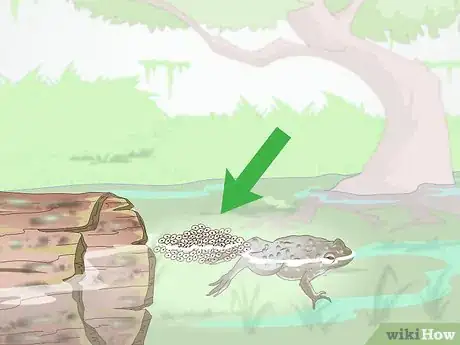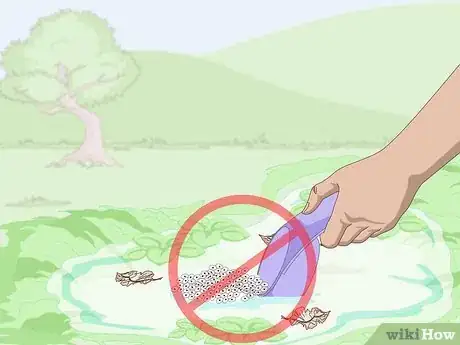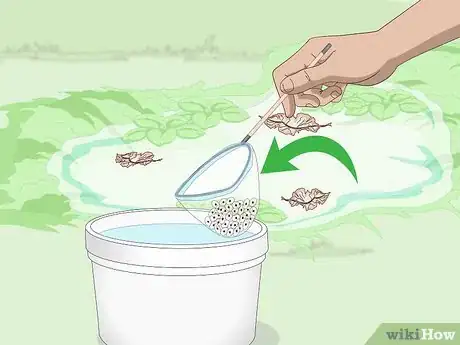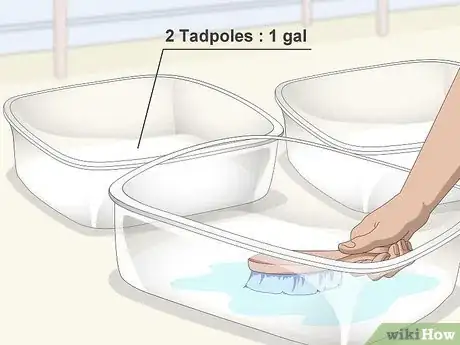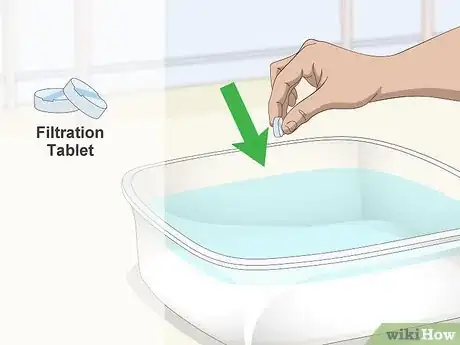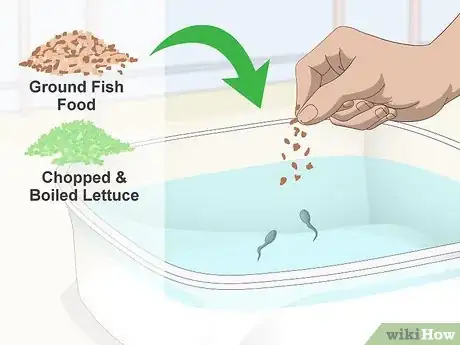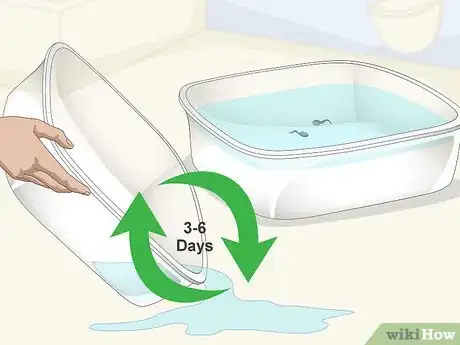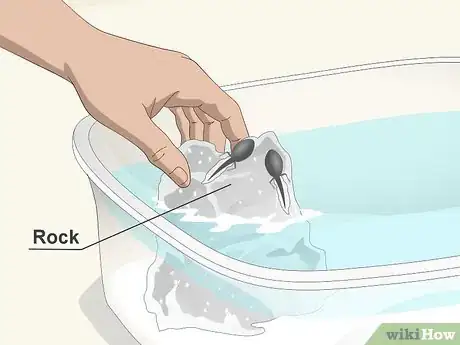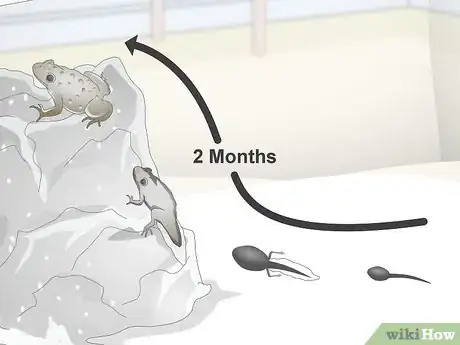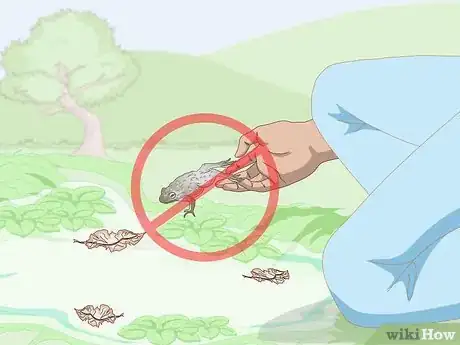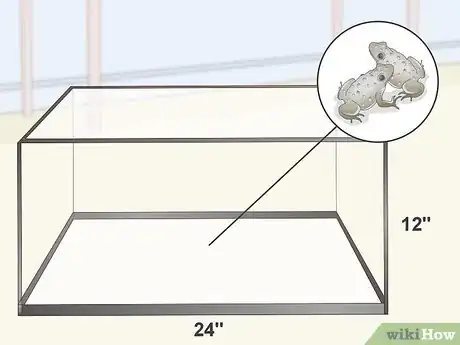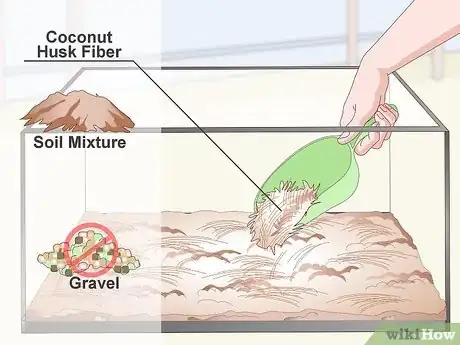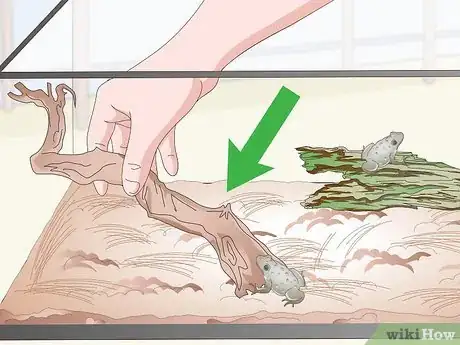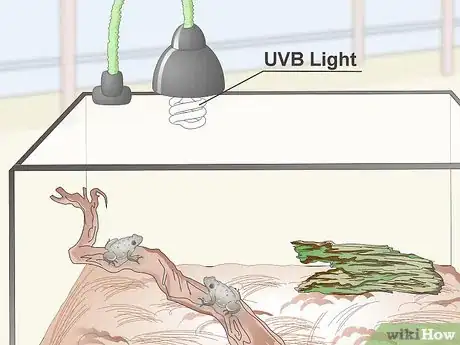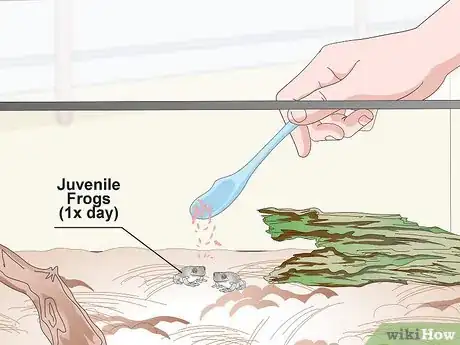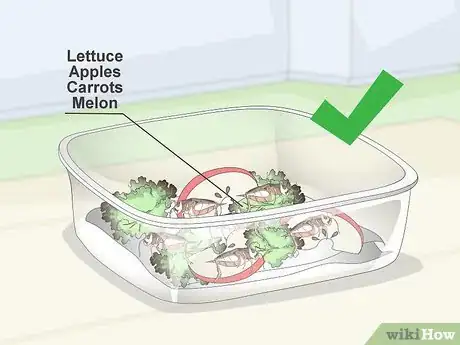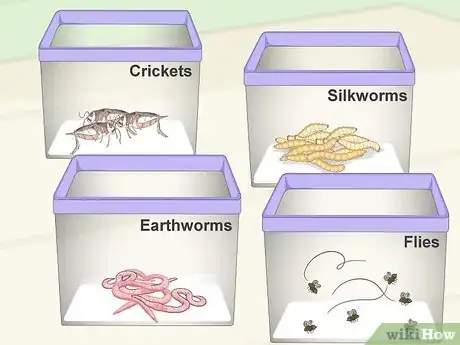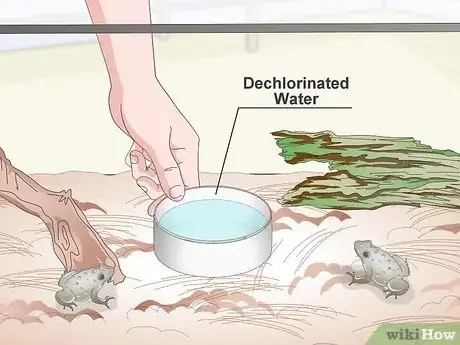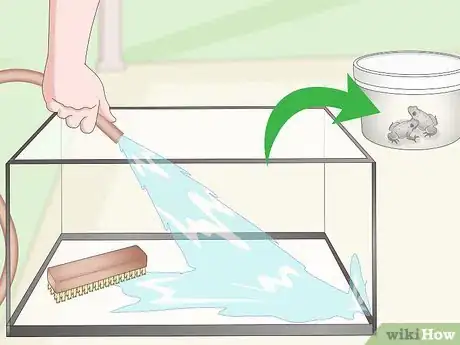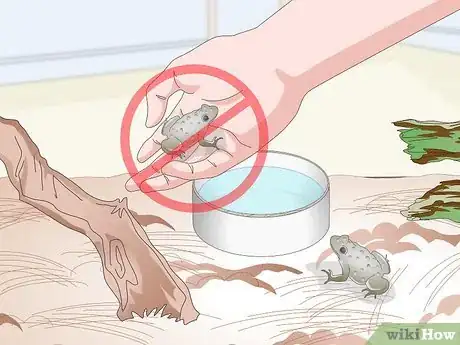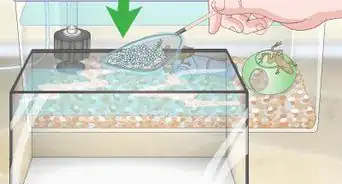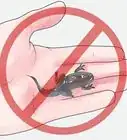This article was co-authored by Pippa Elliott, MRCVS. Dr. Elliott, BVMS, MRCVS is a veterinarian with over 30 years of experience in veterinary surgery and companion animal practice. She graduated from the University of Glasgow in 1987 with a degree in veterinary medicine and surgery. She has worked at the same animal clinic in her hometown for over 20 years.
There are 11 references cited in this article, which can be found at the bottom of the page.
This article has been viewed 21,234 times.
Gray tree frogs are small frogs native to the eastern half of North America. These little creatures live in wooded areas, usually near swamps, ponds, or lakes where damp wood is located. They can be collected as tadpoles in the wild or purchased at pet stores and raised to live in habitats. Their pleasant chirps will bring the sounds of the forest into your home.
Steps
Finding Your Tadpoles
-
1Check your state’s laws on collecting eggs and tadpoles. Many state or provincial governments have laws prohibiting or limiting the collection of eggs and/or tadpoles. States might also prevent you from releasing baby frogs that have transformed back into the wild. Go to your state’s website and check out their fish and wildlife page for details, or contact your representatives.[1]
-
2Find a gray tree frog habitat to collect the right eggs. It may be hard to correctly identify gray tree frog eggs. The eggs are light colored, and the egg mass will be gray on the top and white below. The mama frog will lay them in groups of 20-40 eggs. These groupings may look similar to other woodland frogs’ eggs, so wait to collect them until you know you’re in an area gray tree frogs inhabit.[2]
- Gray tree frogs can be found as far north as Maine in the United States and southern Ontario in Canada. They live throughout the eastern half of North America, going as far west as Texas in the United States and Manitoba in Canada. Anything below northern Florida is too hot for the little guys.[3]
- Gray tree frogs live in trees, rotted logs, and shrubs that are located near ponds, swamps, or lakes. Their eggs will be deposited in shallow water and will float near the surface.
- If you’re unable to find gray tree frogs in the wild, contact local pet stores. They’ll inform you whether they carry or can find domesticated frogs for you to purchase.
Advertisement -
3Collect eggs after April and before July. Gray tree frogs emerge from their winter burrows in April, and they usually begin breeding in May. Begin looking for eggs in late April and continue searching through the spring and early summer months. Don’t collect too many eggs, as you’ll need to provide separate containers for each group of three to four tadpoles.[4]
-
4Avoid removing eggs or tadpoles from public parks or refuges. Most public parks and wildlife refuges have extremely strict rules preventing people from interfering with the environment. These spaces are meant to preserve nature with as little human impact as possible, so be sure to respect that mission. Don’t sneak in after hours to grab eggs or tadpoles![5]
-
5Ask permission to remove eggs or tadpoles from private property. If you have a pond or marsh where gray tree frogs live on your own land, you’re set! If not, but you’ve found a habitat in your neighbor’s woods, talk to them. You don’t want them confused about why you’re trudging through their backyard with plastic containers.[6]
-
6Scoop the eggs and transfer them to a plastic container. Use a long-handled net to gently nudge the eggs directly into the container. Your container should be filled either with water from where you collect the eggs or dechlorinated tap water.
- To filter out chlorine, which is harmful to amphibians, purchase chlorine filter tablets at your local pet store. Each tablet will have different dosage instructions, so be sure you’re following the proper tablet-to-water ratio provided on the instructions.[7]
- You may want to wear rain boots and thick socks when collecting. You’ll probably need to wade into the water, and you don’t want your feet getting wet!
Raising Your Tadpoles
-
1Gather several large plastic containers to house your tadpoles. Clean the containers out with hot water and a good scrub, but do not use soap or cleaners. At first, you can leave your eggs in one container. After your eggs hatch, which should occur within a few weeks, transfer hatched tadpoles with a small scooper to separate containers. Provide one gallon (3.79 L) of water for every two tadpoles.[8]
- Keep your tadpoles from becoming overcrowded as they grow by putting no more than three in each container.
-
2Ensure that your tank water is chlorine-free. Fill your tanks with clear tap water that’s been prepared for your eggs and tadpoles. This will allow you to clearly observe their growth. Use distilled water, or dechlorinate water with filtration tablets purchased at your local pet store, following the instructions to get the right water-to-tablet ratio. You may also want to filter out metals or minerals in your water with a water filter before pouring it in your tank.[9]
-
3Feed your tadpoles ground fish food and chopped and boiled lettuce. Your tadpoles need to be fed twice a day. Provide each tadpole with two tablespoons of prepared lettuce over the course of the day. You should also give each tadpole a pinch of ground-up fish food each day. Watch their food intake, and decrease the amount you feed if your tank gets overly dirty after a day or two.
-
4Change the water every 3-6 days. Your water will quickly become dirty from waste and leftover bits of food. To change the water, transfer the tadpoles to a second tank with pre-filtered water. Then pour out the dirty water and scrub the first tank with hot water and a brush. Do not use cleaning solutions or soap. Rinse the container with filtered water before re-filling it.[10]
-
5Provide a rock for your tadpoles to use to breathe. Your tadpoles need to be able to climb onto “land” as they develop lungs. The rock should emerge fully from the top of the water. Keep this rock at the side of the tank, as tadpoles will naturally swim toward the edge of their water source to find a safe spot for them to surface.[11]
- When your tadpoles begin to develop their legs, cover the tank with a secure screen or a sheet of cheesecloth. This will prevent the little ones from escaping as they become more mobile.
-
6Wait about two months for full metamorphosis to occur. It can be fun and exciting to watch eggs turn into tadpoles and then develop into young frogs. Observe your tank daily to take note of small and big changes. After about eight weeks, your tadpoles should transform completely into young, or juvenile, gray tree frogs.[12]
-
7Avoid releasing your frogs into the wild. Frogs that are hatched and raised in captivity generally don’t do well when reintroduced to the wild. Some states prohibit release to prevent the spread of any diseases your baby frogs could be carrying. If you’re committed to releasing your young frogs, do so right after metamorphosis occurs, and only let the frogs go in the exact spot where you collected the eggs.[13]
- If your frogs appear to be sick, do not release them. Contact a local nature center to ask for assistance treating your frog and helping it become healthy again.
Making a Safe Habitat for Your Frogs
-
1Purchase a large aquarium to safely house your frogs. While you may not think your gray tree frogs look active if you watch them during the day, they’ll take advantage of all the space in their aquarium at night. Give your frogs enough space by choosing a 20-gal. (75.71-L) tank that’s 24 inches (60.96 cm) long and 12 inches (30.48 cm) wide for every pair of adult frogs. This amount of roaming space will keep your frogs happy and healthy.[14]
- Adult gray tree frogs usually measure between about 1.5 and 2.5 inches (3.81-6.35 cm), but don’t be deceived by their small size. Their habitat needs to be much larger than their little bodies might imply.
-
2Keep a screen cover on top of the tank to prevent escapes. Frogs are extremely mobile creatures, and they will escape if your lid isn’t secure. Use a screened cover with strong latches to provide them with enough air while also protecting them from any injuries that could occur if they get out of the tank. Double check that your screen is re-secured each time you open it to give food and water, or clean the tank.[15]
-
3Cover the bottom of the tank with material safe for gray tree frogs. Amphibian tanks need to be lined with what’s called a substrate. This is the material you place at the bottom of the tank to give your frogs a safe and normal habitat. Gray tree frogs do well with coconut husk fiber, soil mixtures appropriate for frogs, and even moistened paper towels. Add a few large river rocks for variety.[16]
- Do not use gravel, small bark, or reptile cage carpeting, as the frogs may swallow and choke on these materials.
- You can find substrates at your local pet store or online.
-
4Give the frogs perches and climbing branches. Gray frogs live in trees and bushes in the wild, so you’ll need to provide them with items they can climb on. Use driftwood, bamboo poles, or PVC pipes resting at different angles in the tank to give them lots of different perches. They’ll also use these items as shelters.[17]
-
5Keep the climate temperate and humid in your frog’s area. Frogs do best when their tank is kept between about 68℉ (20℃) and 78℉ (26℃) during the day. Drop the temperature a few degrees in the room where you keep your frogs at night. Your frogs also need a high-humidity habitat, so mist your aquarium a few times per week to keep it moist.[18]
- To provide your frogs with a range of temperatures within their tank, place a low-wattage heat lamp close to their enclosure. It shouldn’t be directly aimed at the tank.
- If you live in a dry region, increase your misting to once per day.
-
6Provide your frogs with a UVB light. UVB lights are especially essential for young frogs. These lamps, which can be purchased in the reptile section of your local pet store or online, give your frogs access to essential vitamin D. Keep the bulb close to the side or top of the tank, as the UV levels won’t be high enough beyond very short distances.[19]
- Mature gray tree frogs may only need their powder nutritional supplement to get all their essential vitamins.
Providing Routine Care for Your Frogs
-
1Feed metamorphs and juvenile frogs daily. Young frogs have very large appetites. It’s important that you keep them well fed to ensure that they grow and develop properly. For the first two years of your frog’s life, feed them daily.[20]
-
2Feed mature frogs every 2-3 days. Once your frogs reach their second birthday, they’ve reached maturity. These mature, adult frogs should only need to be fed two to three times per week. Start with three to four times per week for the first several months, and ease the frogs down to less feeding times.[21]
-
3Keep crickets to feed your frogs. One of the most high-maintenance aspects of keeping frogs is taking care of their food. Gray tree frogs rely on a diet of live crickets. You can obtain these online or at a local pet store. To keep the crickets alive and healthy, give them a clean and specialized habitat.[22]
- Keep the crickets in a secured and ventilated container lined with paper towels.
- Put an egg carton or crumpled newspaper above the paper towels.
- Offer the crickets fresh lettuce, carrots, melons, and apples to restore their nutrients before you feed them to your frogs.
- Provide the crickets with a water source by soaking a sponge and replacing it daily.
- Keep your cricket container in a space that’s about 70℉ (21℃) or warmer.
- Remove dead crickets from the container, and keep the space clean and dry by replacing the paper towel liner every day or so.
-
4Provide a mixed diet of crickets and other insects. Since you’ve spent so much time caring for your live crickets, your frogs better enjoy them! Offer three to six crickets to each frog at every feeding. Introduce moths, flies, silkworms, or earthworms to add variety to your frogs’ diet every three feedings or so.
- Coat your crickets in powder calcium supplements made for frogs, which can purchased online or at local pet stores. This nutritional supplement should be used every other feeding for adults, and every feeding for youngsters.
-
5Provide a dish of dechlorinated water for soaking. Your frogs need a dish that’s large enough for them to fit their entire body inside. It shouldn’t be so deep that they’ll be submerged underwater when they hop in. This dish should be filled with filtered water and changed whenever it becomes dirty.[23]
- Frogs don’t “drink” water in the same way as humans and many other animals. Instead, they absorb water through an area known as a “drinking patch” located on their belly. That’s why providing a bowl large enough for your frogs to fully soak their whole body is so important.[24]
-
6Clean your frogs’ tank periodically to keep them healthy. Each tank will become dirty at different rates depending on the environment and the frogs. When the sides of your tank start to get covered in debris, or if you notice that your tank smells, it’s time for a cleaning.[25]
- Remove your frogs and place them in a safe temporary container with moistened paper towel linings and one of their perches.
- Empty the tank and scrub it down using hot water and a brush.
- Rinse the tank with filtered water, and then replace each element of your frogs’ habitat.
- You’ll also probably need to scrub and rinse your frogs’ perches and climbing branches.
- Use newly purchased material to give the frogs a fresh, clean substrate.
-
7Avoid handling your frogs. Frogs may become injured or sick if you handle them. Frogs are pets that are best enjoyed from a distance. This will allow you to protect their delicate, little bodies and enjoy watching them grow and live out full lives.[26]
Warnings
- Do not keep the frogs in your room or near where you are sleeping. They’ll likely keep you awake with their nocturnal habits and chirping.⧼thumbs_response⧽
References
- ↑ http://www.amphibianark.org/pdf/Husbandry/Tadpole%20care%20sheet%20with%20guidelines.pdf
- ↑ http://www.in.gov/dnr/fishwild/3341.htm
- ↑ http://eol.org/pages/331209/details
- ↑ http://www.in.gov/dnr/fishwild/3341.htm
- ↑ https://mdc.mo.gov/conmag/1995/07/raising-tadpoles
- ↑ https://mdc.mo.gov/conmag/1995/07/raising-tadpoles
- ↑ http://www.firsttankguide.net/dechlorinator.php
- ↑ https://mdc.mo.gov/conmag/1995/07/raising-tadpoles
- ↑ https://mdc.mo.gov/conmag/1995/07/raising-tadpoles
- ↑ http://www.biosci.missouri.edu/gerhardt/pdfs/tree%20frog%20husbandry.pdf
- ↑ http://www.amphibianark.org/pdf/Husbandry/Tadpole%20care%20sheet%20with%20guidelines.pdf
- ↑ https://mdc.mo.gov/conmag/1995/07/raising-tadpoles
- ↑ http://www.amphibianark.org/pdf/Husbandry/Tadpole%20care%20sheet%20with%20guidelines.pdf
- ↑ http://amphibiancare.com/2012/10/22/gray-tree-frog/
- ↑ http://amphibiancare.com/2012/10/22/gray-tree-frog/
- ↑ http://amphibiancare.com/2012/10/22/gray-tree-frog/
- ↑ http://amphibiancare.com/2012/10/22/gray-tree-frog/
- ↑ http://amphibiancare.com/2012/10/22/gray-tree-frog/
- ↑ http://www.biosci.missouri.edu/gerhardt/pdfs/tree%20frog%20husbandry.pdf
- ↑ http://www.biosci.missouri.edu/gerhardt/pdfs/tree%20frog%20husbandry.pdf
- ↑ http://amphibiancare.com/2012/10/22/gray-tree-frog/
- ↑ http://amphibiancare.com/2005/06/27/crickets-care-breeding/
- ↑ http://amphibiancare.com/2012/10/22/gray-tree-frog/
- ↑ http://www.burkemuseum.org/blog/all-about-frogs
- ↑ http://animals.mom.me/clean-aquarium-full-frogs-2209.html
- ↑ https://www.vetbabble.com/small-pets/frog-care-guide/
About This Article
To raise gray tree frogs, begin looking for eggs or tadpoles from April to July by searching rotted logs, trees, and shrubs near ponds, swamps, or lakes. Once you find some, scoop them into a bucket and make sure to include water from their natural habitat as well. Then, add them to a large plastic container filled with either distilled water or tap water that you've dechlorinated with a filtration tablet. To feed your tadpoles, give them a pinch of ground-up fish food with 2 tablespoons of chopped and boiled lettuce, twice daily. You should also change the water out every 3 to 6 days to keep the tank clean, and provide your tadpoles with a rock to climb on so they can develop lungs and legs. For more tips from our Veterinary co-author, like how to make a safe habitat for adult gray tree frogs, read on!

